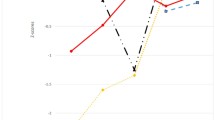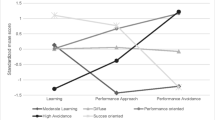Abstract
The aim of this study was to investigate whether students with differing goal achievement orientations were more likely to engage in on-task or off-task mobile device usage, as well as whether particular devices (specifically, laptops and smartphones) have a positive or negative relationship with specific task usage. The results of this study found the mastery approach goal achievement orientation to be negatively associated with off-task device usage, and the mastery avoidance goal achievement orientation to be positively associated with on-task usage behaviors. In addition, it was found that on-task behaviors were positively associated with laptop usage, while off-task behaviors were positively associated with smartphone usage. This study focused on student behavior in a higher education classroom, although the results may be applicable in any context in which users of personal electronic and internet-enabled devices are focused on specific learning objectives.



Similar content being viewed by others
References
Aguilar-Roca, N. M., Williams, A. E., & O’Dowd, D. K. (2012). The impact of laptop-free zones on student performance and attitudes in large lectures. Computers & Education, 59(4), 1300–1308. doi:10.1016/j.compedu.2012.05.002.
Baranik, L. E., Barron, K. E., & Finney, S. J. (2007). Measuring goal orientation in a work domain: Construct validity evidence for the 2 × 2 framework. Educational and Psychological Measurement, 67(4), 697–718. doi:10.1177/0013164406292090.
Bellur, S., Nowak, K. L., & Hull, K. S. (2015). Make it our time: In class multitaskers have lower academic performance. Computers in Human Behavior, 53, 63–70. doi:10.1016/j.chb.2015.06.027.
Bentler, P. M., & Bonnet, D. C. (1980). Significance tests and goodness of fit in the analysis of covariance structures. Psychological Bulletin, 88, 588–606. doi:10.1037/0033-2909.88.3.588.
Cerasoli, C. P., & Ford, M. T. (2014). Intrinsic motivation, performance, and the mediating role of mastery goal orientation: A test of self-determination theory. The Journal of Psychology, 148, 267–286. doi:10.1080/00223980.2013.783778.
Chen, L. H., Wu, C. H., Kee, Y. H., Lin, M. S., & Shui, S. H. (2009). Fear of failure, 2 × 2 achievement goal and self-handicapping: An examination of the hierarchical model of achievement motivation in physical education. Contemporary Educational Psychology, 34(4), 298–305. doi:10.1016/j.cedpsych.2009.06.006.
Chen, Q., & Yan, Z. (2016). Does multitasking with mobile phones affect learning? A review. Computers in Human Behavior, 54, 34–42. doi:10.1016/j.chb.2015.07.047.
Cheong, P. H., Shuter, R., & Suwinyattichaiporn, T. (2016). Managing student digital distractions and hyperconnectivity: Communication strategies and challenges for professorial authority. Communication Education, 65(3), 272-289. doi:10.1080/03634523.2016.1159317.
Dahlstrom, E., & Bichsel, J. (2014). ECAR study of undergraduate students and information technology, 2014. Louisville, CO: Educause Center for Analysis and Research. http://www.educause.edu/ecar.
Dweck, C. S., & Leggett, E. L. (1988). A social cognitive approach to motivation and personality. Psychological Review, 95(2), 256–273. doi:10.1037/0033-295X.95.2.256.
Elliot, A. J., & McGregor, H. A. (2001). A 2 × 2 achievement goal framework. Journal of Personality and Social Psychology, 80(3), 501–519.
Elliot, A. J., McGregor, H. A., & Gable, S. (1999). Achievement goals, study strategies, and exam performance: A mediational analysis. Journal of Educational Psychology, 91, 549–563.
Finn, S., & Inman, J. G. (2004). Digital unity and digital divide. Journal of Research on Technology in Education, 36(3), 297–317. doi:10.1080/15391523.2004.10782417.
Fisher, C. D., Minbashian, A., Beckmann, N., & Wood, R. E. (2013). Task appraisals, emotions, and performance goal orientation. The Journal of Applied Psychology, 98(2), 364–373. doi:10.1037/a0031260.
Fried, C. B. (2008). In-class laptop use and its effects on student learning. Computers & Education, 50(3), 906–914. doi:10.1016/j.compedu.2006.09.006.
Gross, J. J., & Thompson, R. A. (2007). Emotion regulation: Conceptual foundations. In J. J. Gross (Ed.), Handbook of emotion regulation (pp. 3–26). New York: Guilford.
Harackiewicz, J. M., & Linnenbrink, E. A. (2005). Multiple achievement goals and multiple pathways for learning: The agenda and impact of Paul R Pintrich. Educational Psychologist, 40(2), 75–84. doi:10.1207/s15326985ep4002_2.
Junco, R. (2012). In-class multitasking and academic performance. Computers in Human Behavior, 28(6), 2236–2243. doi:10.1016/j.chb.2012.06.031.
Kay, R. H., & Lauricella, S. (2011). Unstructured vs. structured use of laptops in higher education. Journal of Information Technology Education, 10, 33–42.
Kline, R. B. (2010). Principles and practice of structural equation modeling (3rd ed.). New York: Guilford.
Kraushaar, J. M., & Novak, D. C. (2010). Examining the affects of student multitasking with laptops during the lecture. Journal of Information Systems Education, 21(2), 241–252.
Kuznekoff, J. H., Munz, S., & Titsworth, S. (2015). Mobile phones in the classroom: Examining the effects of texting, Twitter, and message content on student learning. Communication Education, 64(3), 344-365. doi:10.1080/03634523.2015.1038727.
Kuznekoff, J. H., & Titsworth, S. (2013). The impact of mobile phone usage on student learning. Communication Education, 62(3), 233–252. doi:10.1080/03634523.2013.767917.
Li, C.-H., Chi, L., Yeh, S.-R., Guo, K.-B., Ou, C.-T., & Kao, C.-C. (2011). Prediction of intrinsic motivation and sports performance using 2 × 2 achievement goal framework 1. Psychological Reports, 108(2), 625–637. doi:10.2466/05.11.14.PR0.108.2.625-637.
Maruyama, G. M. (1998). Basics of structural equation modeling. Thousand Oaks, CA: Sage.
McCoy, B. R. (2013). Digital distractions in the classroom: Student classroom use of digital devices for non-class related purposes. Journal of Media Education, 4(4), 5–12. http://en.calameo.com/read/000091789af53ca4e647f.
Prensky, M. (2001). Digital natives, digital immigrants. On the Horizon, 9(5), 1–6.
Pulkka, A. T., & Niemivirta, M. (2013). Predictive relationships between adult students’ achievement goal orientations, course evaluations, and performance. International Journal of Educational Research, 61, 26–37. doi:10.1016/j.ijer.2013.03.015.
Putwain, D. W., Sander, P., & Larkin, D. (2013). Using the 2 × 2 framework of achievement goals to predict achievement emotions and academic performance. Learning and Individual Differences, 25(2013), 80–84. doi:10.1016/j.lindif.2013.01.006.
Sana, F., Weston, T., & Cepeda, N. J. (2013). Laptop multitasking hinders classroom learning for both users and nearby peers. Computers & Education, 62, 24–31. doi:10.1016/j.compedu.2012.10.003.
Seo, E. H. (2009). The relationship of procrastination with a mastery goal versus an avoidance goal. Social Behavior and Personality, 37(7), 911–920. doi:10.2224/sbp.2009.37.7.911.
Wood, E., Zivcakova, L., Gentile, P., Archer, K., De Pasquale, D., & Nosko, A. (2012). Examining the impact of off-task multi-tasking with technology on real-time classroom learning. Computers & Education, 58(1), 365–374. doi:10.1016/j.compedu.2011.08.029.
Author information
Authors and Affiliations
Corresponding author
Ethics declarations
Conflict of interest
The authors declare that they have no conflict of interest.
Appendix: Full list of goal achievement orientation scale items and device usage questions
Appendix: Full list of goal achievement orientation scale items and device usage questions
Mastery Approach
-
I want to learn as much as possible from this class.
-
It is important for me to understand the content of this class as thoroughly as possible.
-
I desire to completely master the material presented in this class.
Performance Approach
-
It is important for me to do better than other students.
-
It is important for me to do well compared to other students in this class.
-
My goal in this class is to get a better grade than most of the other students.
Mastery Avoidance
-
I worry that I may not learn all that I possibly could in this class.
-
Sometimes I’m afraid that I may not understand the content of this class as thoroughly as I’d like.
-
I am often concerned that I may not learn all that there is to learn in this class.
Performance Avoidance
-
I just want to avoid doing poorly in this class.
-
My goal in this class it to avoid performing poorly.
-
My fear of performing poorly in this class is often what motivates me.
What are some of the reasons that you usually use internet-enabled devices during your Public Speaking discussion section (excluding speech dates)?
Please select all that apply.
-
To take notes in a word processor
-
For social networking (e.g. Facebook, Twitter, etc.)
-
For instant messaging (e.g. Facebook chat, Gchat, etc.)
-
To access HuskyCT for Public Speaking materials
-
To view slides and other materials related to the class
-
To check and respond to personal email
-
To check and respond to email related to Public Speaking
-
To look up more information regarding the topic being discussed in class
-
To look up information unrelated to the class discussion or for entertainment purposes
Please indicate which internet-enabled devices you have used in your Public Speaking discussion section (excluding speech dates).
Please select all that apply.
-
Laptop
-
Tablet device
-
Smartphone
-
eBook
-
Other (please indicate): ___________________
Rights and permissions
About this article
Cite this article
McGloin, R., McGillicuddy, K.T. & Christensen, J.L. The impact of goal achievement orientation on student technology usage in the classroom. J Comput High Educ 29, 240–266 (2017). https://doi.org/10.1007/s12528-017-9134-4
Published:
Issue Date:
DOI: https://doi.org/10.1007/s12528-017-9134-4




